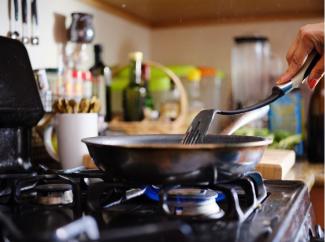The coronavirus pandemic has focused increased attention on indoor air quality and ventilation. Yet, many people remain unaware of the health risks posed by an activity that occurs every day in their homes: cooking.
Any type of cooking, from boiling water to frying food, will produce some amount of indoor air pollution. One of the most serious pollutants is particulate matter (fine particles), which is generated by cooking food and heating oil on all types of stoves. Cooking with gas produces harmful combustion products like nitrogen dioxide and carbon monoxide, and both gas stoves and electric stove burners generate ultrafine particles. These cooking-related pollutants are linked to health impacts, including respiratory problems and cardiovascular disease, and some people—including children, older adults, people with underlying conditions, and people who have been socially and economically disadvantaged—are at increased risk of harm from exposure.

Fortunately, addressing this widespread problem does not require people to stop cooking indoors, or even to decrease the frequency. It does, however, require attention to factors like stove type, cooking methods, and perhaps most importantly, ventilation. To some extent, all these factors are determined by individual choices and behaviors, but they also are driven by governments that adopt policies around how homes are designed, constructed, and maintained—especially when it comes to ventilation.
Public awareness of the importance of adequate ventilation is increasing, due in part to the pandemic, and whole-house mechanical ventilation (or “dwelling unit ventilation”) provides an important baseline for good indoor air quality. However, it is local exhaust ventilation that reduces indoor pollution at or near its source.
Kitchen exhaust systems like range hoods are key to preventing cooking-related pollutants from mixing with the rest of the indoor air and accumulating to unhealthy levels in homes, especially in smaller dwellings such as apartments, where there is less indoor air volume to dilute the pollutant concentrations. Yet, despite the importance of ventilation to public health, new houses and apartments are still being built without adequate kitchen exhaust systems installed.
States, tribes, and local governments have an important role to play in addressing this gap. As a new report from the Environmental Law Institute explains, a critical first step is for jurisdictions to adopt building codes or other policies requiring installation of range hoods or other kitchen ventilation systems in all new and renovated residential buildings. But governments can go further by establishing stronger ventilation performance standards that ensure all homes have the capacity to remove cooking pollutants effectively, regardless of dwelling size or stove type.
The California Energy Commission is aiming to do just that. This month, the agency released for public review and comment proposed changes to California’s statewide building code that would significantly strengthen the state’s current requirements for kitchen ventilation. As described in the ELI report, the proposed performance standards for kitchen ventilation systems include differential requirements for gas and electric stoves that are based on a home’s square footage.
Of course, reducing cooking pollutant exposure in existing homes is no less important than in new construction, and there are opportunities to improve kitchen ventilation in the existing housing stock. The new ELI report suggests how housing codes might be used to address kitchen ventilation and describes funding programs that could be tapped to assist lower-income families in making ventilation improvements to their homes.
With people cooking more meals at home and the public becoming more aware of the importance of ventilation, 2021 is an opportune time for policymakers to act to improve public health and reduce exposure to cooking pollutants. In the meantime, however, households can implement simple changes to cooking practices that help reduce exposure, regardless of policy in their jurisdiction. These best practices include running the ventilation system (or opening windows) during every cooking event; cooking on the back burners; using cooking oils with high smoke temperatures (e.g., sunflower oil and canola oil); and covering pots and pans to reduce particle emissions from oil and food.
The report and other policy resources on indoor environmental quality are available through ELI’s Indoor Environments program: http://www.eli.org/buildings.
